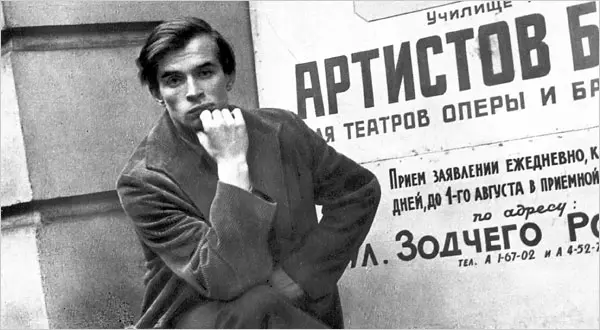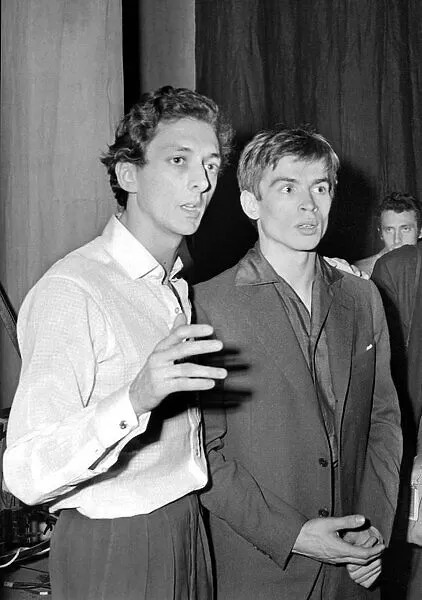Rudolf Nureyev is undoubtedly an iconic name for ballet around the world. This year he would be 85 and I’d like to make a little homage to him and the specific role of Paris in his life. I choose his connection with Paris and Paris Opera Ballet for La Notte French Season, being absolutely sure that Paris, always raging city of freedom, played the symbolic role in Nureyev’s life.

Photos: Rudolf Nyreyev by Richard Avedon (Paris, 1961) \
Paris from the Harper's Bazaar Collection
It all started in 1961 when Nureyev’s performances astonished the audience during the Kirov Ballet (now – Mariinsky Ballet) tour in Paris.
Oliver Merlin wrote for Le Monde,
“I will never forget his arrival running across the back of the stage, and his catlike way of holding himself opposite the ramp. He wore a white sash over an ultramarine costume, had large wild eyes and hollow cheeks under a turban topped with a spray of feathers, bulging thighs, immaculate tights. This was already Nijinsky in Firebird.”

Rudolf Nureyev near the Vaganova Academy in Leningrad, circa 1960.
Credit: Tamara Zakrzhevskaya/WNET New York and BBC
Nureyev broke the rules about mingling with foreigners for soviet dancers and the KGB wanted to send him back to the Soviet Union, in this case he could be imprisoned or prohibited of going abroad. On 16 June 1961 when the Kirov company was to fly to London from Paris, Nureyev was told that he must return to Moscow for a special performance in the Kremlin, rather than go on to London with the rest of the company. He refused, because understood all danger of returning back to the USSR in his case.

Director of the International Ballet of the Marquis de Cuevas Mr. Larrain talks 22 June 1961 with Soviet born ballet dancer Rudolf Nureyev at the Theatre des Champs Elyses in Paris where he will perform with the troop / AFP PHOTO
After he found the way to stay in Paris, becoming the dancer of Grand Ballet du Marquis de Cuevas, Rudolf Nureyev made his first appearance with a European ballet company. The company had regular Paris seasons and toured in France with its classical repertoire. He performed the role of the prince in Sleeping Beauty on the 23rd June 1961, with Nina Vyroubova in Raymundo de Larrain’s production at the Champs Elysées Theatre. He also danced the Blue Bird on the 30th June of the same year, but he worked with the company only few months.

Alain Delon with Rudolf Nureyev, Paris, 1960's
Then after Dame Ninette de Valois offered him a contract to join The Royal Ballet as Principal Dancer, Nureyev worked in London up to 1970, the world was amazed by their magnificent duo with Margot Fonteyn. During 1970s, being an extremely sought-after guest-principal and still performing regularly with The Royal Ballet, he repeatedly performed in duets with the best ballerinas around the world, including Yvette Chauviré, who is considered as France's greatest ballerina and the legend of Paris Opera Ballet of XX century.

Yvette Chauviré performing with Rudolf Nureyev in the early 1960s.
Photograph: Popper/Ullstein Bild/Getty
Alongside his incredible talent as a fantastic dancer and performer, there is one more – the choreographer. Let's take a closer look at Manfred, the first ballet staged by Nureyev for the Paris Opera in 1979. It was first performed on November 20, 1979 at the Palais des Sports, with Jean Guizerix and Wilfride Piollet in the principal roles.
Nureyev was inspired not only the Byron’s poem, in his Manfred he mixed the character with the personality of author himself. The ballet is very interesting from the point of adding the various motifs borrowed from other poems by Byron.

Rudolf Nureyev in Manfred. Photo: Francette Levieux. Fondation Rudolf Nureyev
Nureyev was not able to dance the premiere of Manfred himself, despite he was preparing the role, he was replaced by Jean Guizerix. On December 15, 1979, the choreographer finally danced this role based on a key character of the Romanticism and who seemed very close to his own personality. Then the new version, without décor, and with costumes by Nicholas Georgiadis, was performed firstly in Zurich and revived at the Paris Opera in 1986.
Here we can see the male character as the center of the idea, for Rudolf Nureyev the image of male character and male performer was the most significant in each ballet creation he was making subsequently in Paris Opera.
Manfred by Rudolf Noureev (performed by Mathias Heymann, 2020)
Nureyev was the director of the Paris Opera Ballet from 1983 to 1989 and made his versions of the classical masterpieces such as Don Quichotte (1981), Raymonda (1983), Swan Lake (1984), Romeo and Juliet (1984), The Nutcracker (1985), Cinderella (1986), Sleeping Beauty (1989) and La Bayadère (1992) for Paris Opera Ballet repertoire.
About his work with dancers Charles Jude once said,
“Rudolf is there in my mind. I can still hear his voice, his wheeze, every time I correct a dancer. Just as he, when he corrected us, could probably hear the words of his own teacher in his head.”
Rudolf Nureyev was the person who began a new tradition at the Paris Opera by naming the new Etoiles solemnly on stage at the end of a performance in the presence of the audience. Being the director of Paris Opera Ballet, he nominated such ballerinas and dancers as Sylvie Guillem, Isabelle Guerin, Manuel Legris, Laurent Hilaire and Elisabeth Maurin as the Etoiles.
In the following materials I’m planning to introduce each of Nureyev’s productions in Paris. Stay tuned and follow our social media!
Information: The Rudolf Nureyev Foundation, Opéra National de Paris, open sources
Text: Julia Sumzina
